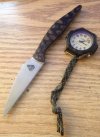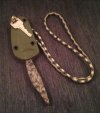Its odd to me how for some people, tool/carbon steels will rust for them immediately, yet I have never had this problem really. I live a mile from a lake, and 45 miles from Lake Michigan. Its very humid in the summers, very wet in the winter. Yet even after sitting for about 2 years my CPM-M4 GB only had like 3 tiny spots of surface rust. Granted, it was inside, but still, stored at my parents house and my dad is stingy about A/C (until the last year) so it was mostly windows open my whole life except when it was above 85 degrees.
My GB has been to Galveston, TX a few times, at my grandfather (now aunt's) camp. No real issues with salt air.
However, I am not someone that does much food processing with my knives. Occasionally a steak or chicken, but nothing acidic like fruits and vegetables. I generally reserve that for kitchen knives. I also have dry skin and do not sweat unless its 90 degrees and I'm outside. So maybe that has something to do with it.
I've yet to own an LC200n knife, though my dad has a Spyderco Aqua Salt he's taken fishing a few times. I bought it as an impulse for the steel, but I never use fixed blades so I gave it to him.
As others said, its a specialized steel. If you were someone like (can't remember his name now hooray for memory loss!) that paddle kayaks in the pacific and is constantly filleting fish in salt air/water, I can see needing a knife with it. But for a daily use steel? Meh.


